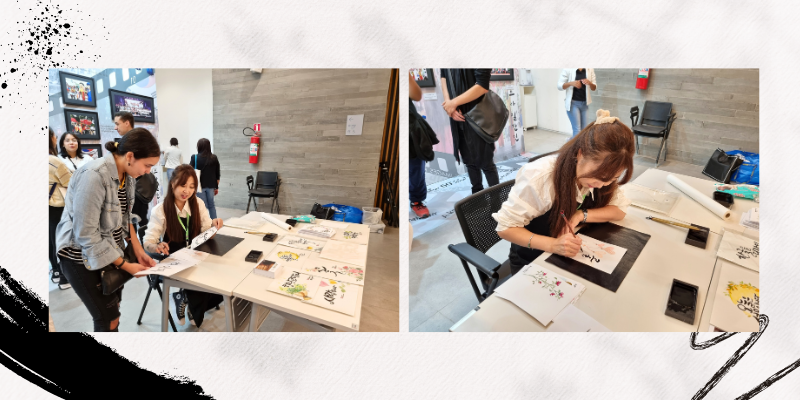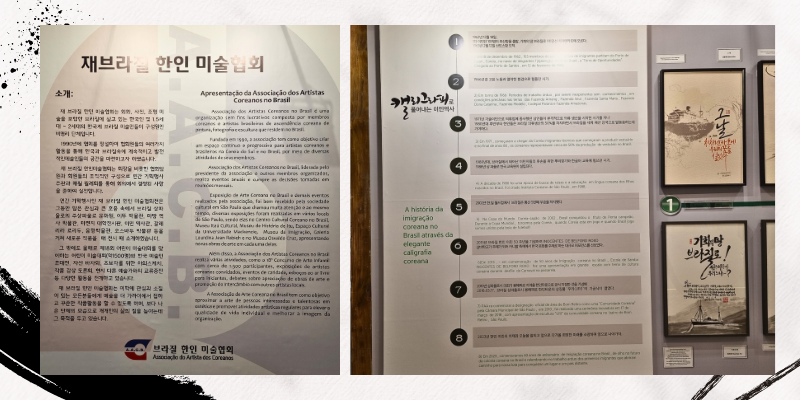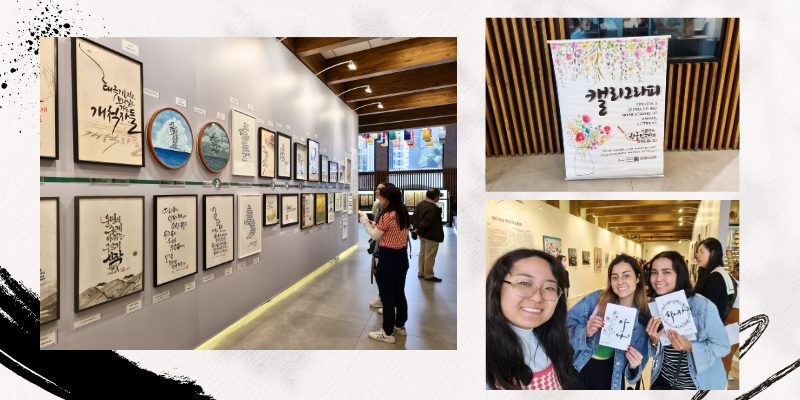- 한국어
- English
- 日本語
- 中文
- العربية
- Español
- Français
- Deutsch
- Pусский
- Tiếng Việt
- Indonesian
By Honorary Reporter Ana Caroline Bergamaschi Farias from Brazil
Photos = Ana Caroline Bergamaschi Farias
The Korean Culture Center (KCC) in Sao Paulo, Brazil, hosted the event "Korean Hangeul Calligraphy with a Brush: An Abstract Approach" in collaboration with the Korea Culture Artist Association in Brazil.
A notable attendee was Korean Brazilian artist and Hangeul calligraphy instructor Gloria Kim, who described her passion for modern Hangeul calligraphy in a May 29 interview via Instagram.

Hangeul calligraphy instructor Gloria Kim (seated) shows off her art using visitors' names.
Briefly introduce yourself.
My name is Kim Yun-hee and my Brazilian name is Gloria. I teach modern Korean calligraphy and was certified by the Korean Artists and Culture Association. Over the years, I have dedicated myself to improving my skills and knowledge in this art and feel honored that my passion is my line of work.
How did you get so interested in modern Hangeul calligraphy?
It was through my educational background in art. Calligraphy is a fascinating form of art that combines artistic elements with written communication through which we can explore the form, rhythm and composition of the words to create unique visual expressions. My arts background gives me a solid foundation to explore calligraphy on a creative and technical level by using artistic and aesthetic principles, yet I'm constantly learning and seeking new techniques. I'm also trying to show others the beauty of modern Hangeul calligraphy.
What is your role in the Korean Culture Artist Association?
My job is to organize activities and making sure that everything is coordinated. I maintain communication among members, organize meetings and help with whatever is necessary. Our association comprises artists who have completed basic and intermediate calligraphy courses. Through regular meetings, we learn together, explore new themes and techniques, and plan exhibitions and competitions to share our works with the public. We seek to preserve and promote the art of Hangeul calligraphy.

The history of Korean immigration in Brazil is shown through modern Hangeul calligraphy.
How was the KCC in Brazil's event to mark the 60th anniversary of Korean immigration?
It was an exciting and rewarding experience to see visitors get involved and try to write their names with a Korean calligraphy brush. Everyone was intrigued by the styles of Hangeul letters. Toward the end, we presented participants with a card containing their names in Hangeul calligraphy accompanied by a beautiful watercolor painting. This connection allowed visitors to approach Korean culture in a creative and meaningful way.
What is behind rising Brazilian interest in Korean culture, especially calligraphy?
I think the popularity of Korean culture is mostly due to greater exposure of Korean content like music, TV shows and films. Hangeul calligraphy attracts people with its elegance and cultural significance as a form of art that combines technical skill with personal expression.

The KCC holds a Hangeul calligraphy exhibition (left) and to the right is a photo of my friends and I at the event.
Any message to those interested in learning modern Korean calligraphy?
Continue to explore your passion and develop your own unique style. Don't be afraid to take the first step. Practice regularly and enjoy the creative journey.
msjeon22@korea.kr
*This article is written by a Korea.net Honorary Reporter. Our group of Honorary Reporters are from all around the world, and they share with Korea.net their love and passion for all things.
Most popular
- Korea.net welcomes 2025 K-influencers, Honorary Reporters
- 2025 Honorary Reporter class pledges to spread 'real Korea' worldwide
- US urged to exempt tariffs on Korea in first '2+2' trade talks
- 'Gangnam Style,' 'Baby Shark' make YouTube's 2005-25 best list
- Korean culture festival in Cuba marks 1st year of bilateral ties
